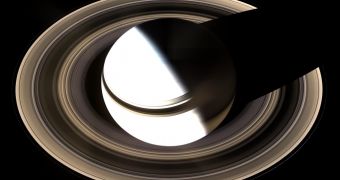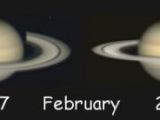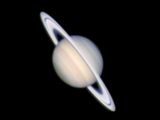Saturn is the second largest planet in the solar system and probably the most beautiful of all, aside Earth maybe. Its beautiful rings are simply breathtaking, thus even some of the most experienced astronomers cannot help themselves from taking a peek through the telescope from time to time to see its rings. However, something surprising is taking place now. It looks like Saturn's rings are slowly vanishing. The effect has been noticed by most of the astronomers on Earth, as the rings are turning into a thin line until they completely fade into darkness.
One of the astronomers conducting regular observations on Saturn, with the help of small telescopes, is Efrain Morales Rivera from Aguadillar, Puerto Rico. "The rings have narrowed considerably in the last year. The Cassini division is getting hard to see," said Rivera. The Cassini division is actually a dark gap within the rings.
When the planet was first observed with the help of a spy glass telescope, Galileo was baffled of what he saw. Saturn appeared to him as something never before seen. The appearance of the rings was so surprising that he immediately wrote to his patrons announcing the puzzling discovery. However, in less than a year, the rings vanished slightly from sight.
The cause
The phenomenon is known to modern astronomers as "ring plane crossing," meaning that on its trajectory around the Sun, Saturn changes its tilt in relation to our planet. This happens each 14 years or so, because the plane of the rings intersects our planet which renders them invisible from the surface of the Earth. According to astronomers, by September 4, 2009, the planet would have tilted so much on its axis that the rings would appear to vanish altogether.
Two years after his discovery, Galileo stopped studying Saturn, which may have been one of the biggest mistakes in his life, because of the fact that during the time when the rings start to fade away, fainter rings and the moons of the planet start to become more obvious.
Blue skies
Additionally, the disappearance of the rings from view enables astronomers to view one of the most curious phenomenons on Saturn, namely its blue north pole. During the first year of survey of the planet, the Cassini orbiter revealed that the north pole of Saturn appeared as blue as the skies on Earth, while the usual color of Saturn's atmosphere is gold. Now, with the rings at a tilt of only 8 degrees in relation to Earth, the blue northern hemisphere starts to become obvious from the Earth as well.
Although the first to discover them, Galileo never knew what the rings really were and he often described them as lobes posted on each side of the planet. But he somehow knew that their disappearance and reappearance was periodical. Later, Jean Chapelain revealed that the rings couldn't have been solid, while Christaan Huygens is credited for being the first to explain the process that leads to the disappearance of the rings.
Even so, more than two centuries passed before astronomers finally accepted the findings of the two. Since its discovery in 1610, Saturn has executed about 27 plane crossings. On March 19, Saturn will be visible in the same part of the sky as the Moon, appearing to the naked eye as a golden 'star'. If you miss this date, you can try again on the 14th and 15th of April. Don't miss a 'golden' opportunity!

 14 DAY TRIAL //
14 DAY TRIAL // 

